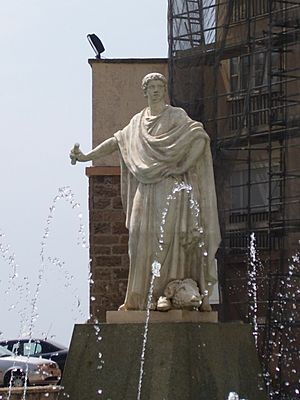Lucius Cornelius Balbus (proconsul) facts for kids
Lucius Cornelius Balbus was a Roman politician and general who lived a long time ago, in the 1st century BC. He was from a city called Gades (which is in modern-day Spain). Even though his family wasn't originally Roman, he became a Roman citizen and did many important things for the early Roman Empire. He also helped build impressive buildings in Rome, the capital city.
Life and Achievements
During a big fight called the civil war, Balbus worked for Julius Caesar. Caesar trusted him with many important jobs. Balbus also fought in wars in Alexandria and Spain. Because of his great service, he was allowed to join a special group of priests called the college of pontiffs.
Later, in 44 BC, Balbus worked as a quaestor (a Roman official who managed money) in a part of Spain called Further Spain. After this, he went to Mauretania, a kingdom in North Africa.
Many years later, in 21 BC, Balbus became a Proconsul (a governor) of the Roman province of Africa. This was a very important job.
In 19 BC, Balbus led Roman soldiers to defeat a group of people called the Garamantes. He even went on a famous trip into Sub-Saharan Africa. For his victory, he was given a special parade called a triumph on March 27, 19 BC. This was a very rare honor, especially for someone who wasn't born a Roman citizen.
Balbus also built a beautiful building in Rome called the Theatre of Balbus. It was opened in 13 BC when Emperor Augustus returned from Gaul.
Balbus was also interested in writing. He wrote a play about his visit to Pompey's camp. He also wrote a book about the Roman gods and how people worshipped them.
Balbus's Journey to Africa
One of the most interesting things Balbus did was lead an expedition into the Sahara Desert. This was probably the first time Romans explored so far south. In 19 BC, he likely reached the Niger river in what is now Mali.
His journey started from a city called Sabratha in Libya. He conquered the capital city of the Garamantes in Fezzan. Then, he sent a small group of his soldiers even further south. They crossed the Ahaggar mountains to explore a "land of lions." There, they found a huge river, which they thought was the Niger. They believed it flowed towards the Nile river.
In 1955, many Roman coins and pieces of pottery were found in the area of modern-day Mali. This suggests that Romans did indeed travel to this region.
According to ancient writers like Pliny, Balbus's expedition conquered several cities like Gadames and Ghat. After taking over the Garamantian capital of Garama, the Roman soldiers continued south. They reached oases and rivers that existed back then but have since disappeared. Some historians believe Balbus used an old caravan route. Along this route, there are ancient stone carvings showing Garamantian chariots. The Romans then crossed into what is now Niger and reached the Niger river near Gao, after passing through a trading center called Tabemekka in Mali.
More recently, Roman coins have been found in the northern part of Mali. This further supports the idea that Romans traveled deep into the Sahara. Many Roman objects have been found in the Sahara, especially along the old trade routes. For example, many Roman items were discovered at the Garamantian capital of Germa in the Fezzan.
See also
 In Spanish: Lucio Cornelio Balbo el Menor para niños
In Spanish: Lucio Cornelio Balbo el Menor para niños
- Tin Hinan Tomb
- Romans in Sub-Saharan Africa


